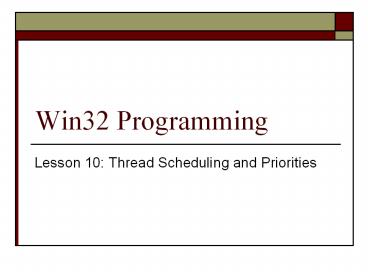Win32 Programming PowerPoint PPT Presentation
1 / 21
Title: Win32 Programming
1
Win32 Programming
- Lesson 10 Thread Scheduling and Priorities
2
Where are we?
- Weve got thread basics worked out
- But its very helpful to understand how the OS
deals with thread scheduling - This lesson, well work on scheduling threads
understanding how each one gets executed on the
machine
3
Thread Context
- Remember the kernel keeps a copy of the thread
context which contains important runtime
information - Such as?
- Every 20ms or so, Windows looks at the thread
contexts on the machine and decided which to
allow to run - This is known as a context switch see a tool
like Spy
4
Context Switch (cntd)
- After about 20ms, the Operating System saves the
processors internal state to threads context
and looks for the next thread to execute - This cycle continues until the system shuts down
- Only schedulable threads can be run
5
Example Notepad
- When Notepad is just sitting about as a Window
with nothing to do, it is not marked schedulable - When the OS sees that the Windows has been moved
or typed in, the thread is marked as schedulable - NB This is not the same as actually running the
thread that still depends on the OS scheduler
6
Ensuring you get run
- Often, want to make sure that there is no latency
between a particular action (maybe data arriving
on a port) and response - How?
- Sorry, cant be done easily. Windows is not a
Real-time operating system
7
Suspending and Resuming Threads
- DWORD ResumeThread(HANDLE hThread)
- DWORD SuspendThread(HANDLE hThread)
- NB A thread can be suspended multiple times. If
a thread is suspended more than once, it must be
resumed more than once before it becomes
schedulable - Danger, Will Robinson!
- Randomly suspending a thread can cause deadlocks.
Dont do this unless you know exactly what the
thread is doing!
8
Example Suspending a Process
- Why is the idea of suspending a process
meaningless? - What do we mean when we do this?
- Lets look at an example from VS2008
9
Sleeping
- A thread can tell the OS that it wants to go to
sleep (that is, be unscheduled for a certain
amount of time) - VOID Sleep(DWORD dwMilliseconds)
- Calling Sleep automatically gives up the rest of
this time slice - The time to sleep is approximate remember,
Windows is not a real-time OS - You can call Sleep with the parameter INFINITE.
This is not useful. - You can call Sleep with the parameter 0 to give
up the remainder of this timeslice
10
Switching to another Thread
- Imagine you have a low-priority thread locking a
resource - Can use BOOL SwitchToThread()
- See if another thread is CPU starved and waiting
- Returns FALSE if no other thread can run
- Similar to Sleep except lower-priority threads
also execute
11
Aside ThreadExecution Times
- Naively, most simply take the time at the start
of a code block and the end, and subtract - No guarantee there werent thread switches in
there! - Instead, can use
- BOOL GetThreadTimes( HANDLE hThread,
PFILETIME pftCreationTime,
PFILETIME pftExitTime, PFILETIME pftKernelT
ime, PFILETIME pftUserTime)
12
Thread Context Revisited
- There is actually a structure for the thread
context documented by Microsoft ooh! - Declared in winnt.h (see here for details)
- So, if we wanted to we could stop a running
thread and modify its context well, lets look
at the example in the book
13
Thread Priorities
- Each thread can execute at a different priority
- Priorities are assigned from 0 (lowest) to 31
(highest) - When the scheduler assigns a thread it always
passes control to a priority 31 thread if there
are any available to run - And so on, down the priorities
14
Caveat Emptor
- Microsoft does not fully document the behavior of
the scheduler - Microsoft tells you the scheduler is subject to
change - Microsoft provides an abstraction layer you
cant talk to the scheduler directly
15
Windows Priorities
- Six process levels
- Real-time respond immediately to time-critical
messages. This priority is higher than task
manager it you use it, you can hang the
machine! BE CAREFUL! - High threads which must respond. This is how
task manager runs - Above normal between high and normal
- Normal No special scheduling needs
- Below normal between normal and idle
- Idle Only run when the system is basically idle
16
And then threads
- You can set the relative thread priorities too
- This sets the overall priority
- So, this all sounds good, but how do you do it?
17
Programming Priorities
- Parameter to CreateProcess
- REALTIME_PRIORITY_CLASS, HIGH_PRIORITY_CLASS,
ABOVE_NORMAL_PRIORITY_CLASS, NORMAL_PRIORITY_CLASS
, BELOW_NORMAL_PRIORITY_CLASS, IDLE_PRIORITY_CLASS
18
DIY
- A process can also call BOOL SetPriorityClass(HAND
LE hProcess, DWORD fwdPriority) - Example SetPriorityClass(GetCurrentProcess(),
IDLE_PRIORITY_CLASS) - Also DWORD GetPriorityClass(HANDLE hProcess)
- Similarly SetThreadPriority(HANDLE hThread, int
nPriority)
19
Tweaking the Scheduler
- Can optimize the foreground or background
processes
20
Affinities
- Can control which processor a thread executes on,
on a multi-processor machine - Why does this matter?
21
Assignment
- Threading is a very useful technique
- Write a network server which listens on Port
31337 - The server should handle multiple clients,
creating a new thread for each client - The server simply echoes back what you type (but
waits for a newline) - A session is closed when the string close is
typed to the server - The console should provide a simple output which
details the number of threads in use when asked - Also, the console should remain responsive to a
shutdown request

